Papers by Francisco Tiago De Vasconcelos Melo
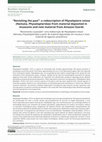
Revista Brasileira de Parasitologia Veterinária
Physaloptera Rudolphi, 1819 is a genus of nematodes that includes approximately 100 species paras... more Physaloptera Rudolphi, 1819 is a genus of nematodes that includes approximately 100 species parasitic in vertebrates around the world. From these, approximately 30 occur in the Neotropical region, with nine reported from neotropical reptiles. Physaloptera spp. are recognized by their distinct morphology of the apical end and characters of the reproductive system. However, despite the fact that the morphological characters for species diagnosis have been firmly established, we frequently find identification problems regarding poorly detailed descriptions and poorly preserved specimens. These may lead to taxonomic incongruencies. Physaloptera retusa (Rudolphi, 1819) is the most common species of the genus and has been reported from several species of neotropical reptiles. Based on our reexaminations of nematode specimens identified as P. retusa from different museum collections, we provide a detailed redescription including the type material, voucher specimens and new specimens recove...

Journal of Helminthology, Feb 26, 2014
Aspidogastreans are commonly found infecting freshwater and marine molluscs, teleosts fishes and ... more Aspidogastreans are commonly found infecting freshwater and marine molluscs, teleosts fishes and freshwater turtles. The subclass comprises four families – Rugogastridae Schell 1973, Stichocotylidae Faust &amp; Tang 1936, Multicalycidae Gibson &amp; Chinabut 1984 and Aspidogastridae Poche 1907 – and it is characterized by the presence of a ventral adhesive disc divided into rows of alveoli. In the current work, using light and scanning electron microscopy and molecular approaches, a new species of Aspidogastridae of the genus Rohdella Gibson &amp; Chinabut, 1984, is described as a parasite of Colomesus psittacus in Brazil. The new taxon is distinguishable by the presence of oesophageal glands, teguments covered by ciliated papillae, and the position and shape of the hermaphroditic duct. The present work describes the third species of the genus Rohdella, thereby adding new morphological and molecular data regarding Aspidogastridae.
Systematic Parasitology, Aug 15, 2013
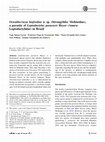
Systematic Parasitology, Aug 20, 2018
Leptodactylus paraensis Heyer, is a Neotropical anuran species that inhabits Rainforest habitats ... more Leptodactylus paraensis Heyer, is a Neotropical anuran species that inhabits Rainforest habitats in the eastern Amazon, but because it has only been recently separated from the Leptodactylus pentadactylus (Laurenti) species group, little is known about its helminth fauna. This study describes a new species of Oswaldocruzia Travassos, 1917 and records the first occurrence of this genus parasitising L. paraensis and the second species for the Caxiuanã National Forest in the eastern Amazon, Brazil. Oswaldocruzia lanfrediae n. sp. is characterised by having an anterior extremity with a smooth cephalic vesicle divided into two portions, a claviform oesophagus, well-developed cuticular longitudinal ridges and lateral alae. Females have a well-developed ovojector, with didelphic and amphidelphic uteri. Males show complex robust spicules divided into a slightly curved shoe, a bifurcated fork and a blade terminating in 2-3 processes. The new species differs from its congeners especially regarding the lateral alae and the morphology of the spicules, in addition to morphometric characters such as body size, oesophagus length, deirid position, nerve-ring position and relative position of the vulva in females. A1 This article was registered in the Official Register of Zoological A2 Nomenclature (ZooBank) as 7A27C67E-87E4-490C-907A-A3 12006B4C8EC2. This article was published as an Online First A4 article on the online publication date shown on this page. The A5 article should be cited by using the doi number. This is the A6 Version of Record. A7 This article is part of the Topical Collection Nematoda.
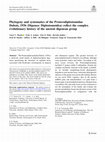
Systematic Parasitology, 2020
The Proterodiplostomidae Dubois, 1936 is a relatively small family of diplostomoidean digeneans p... more The Proterodiplostomidae Dubois, 1936 is a relatively small family of diplostomoidean digeneans parasitising the intestines of reptilian hosts associated with freshwater environments in tropical and subtropical regions. The greatest diversity of proterodiplostomids is found in crocodilians, although some parasitise snakes and turtles. According to the most recent revision, the Proterodiplostomidae included 17 genera within 5 subfamilies. Despite the complex taxonomic structure of the family, availability of testable morphology-based phylogenetic hypotheses and ancient hosts, molecular phylogenetic analyses of the group were practically lacking. Herein, we use novel DNA sequence data of the nuclear lsrRNA gene and mitochondrial cox1 gene from a broad range of proterodiplostomid taxa obtained from crocodilian, fish, and snake hosts on four continents to test the monophyly of the family and evaluate the present morphology-based classification system of the Proterodiplostomidae in comparison with the This article was registered in the Official Register of Zoological Nomenclature (ZooBank) as urn:lsid:zoobank.org:pub:C7731 46C-F377-4C30-A73A-318D21119F9C. This article was published as an Online First article on the online publication date shown on this page. The article should be cited by using the doi number. This is the Version of Record.
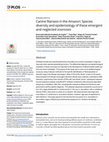
PloS one, 2018
Dirofilaria immitis and Acanthocheilonema reconditum are common parasites in dogs but have also b... more Dirofilaria immitis and Acanthocheilonema reconditum are common parasites in dogs but have also been reported parasitizing humans. The differential diagnosis and epidemiological evaluation of these zoonoses are important to the development of efficient public health policies and control strategies. The purpose of this study was to carry out an epidemiological survey by using molecular methods for the specific identification of filarid parasites of domestic dogs in the Marajó mesoregion, State of Pará (PA), Brazil. A total of 418 canine blood samples from Marajó mesoregion (Northern Brazil) were collected, submitted to DNA extraction, polymerase chain reaction (PCR) with "pan filarial" primer, subsequent sequencing and sequence analysis using BLASTn software comparison with previously deposited sequences in GenBank. After that, a phylogenetic analysis by Maximum Parsimony was performed to aid the specific diagnosis. The obtained sequences showed the occurrence of 9 (2.15%) ...
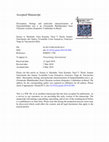
Parasitology international, Jan 9, 2018
A new species of the genus Serpentirhabdias Tkach, Kuzmin et Snyder, 2014, S. moi n. sp., is desc... more A new species of the genus Serpentirhabdias Tkach, Kuzmin et Snyder, 2014, S. moi n. sp., is described from a colubroid snake Chironius exoletus from Caxiuanã National Forest, State of Pará, Brazil. The species is characterised by having a triangular oral opening, absence of the buccal capsule, presence of six minute onchia in the oesophastome, and excretory glands of approximately the same length as the oesophagus. These qualitative morphological characters, as well as some measurements, differentiate the new species from other Neotropical and Nearctic Serpentirhabdias spp. The morphological description of parasitic adults of S. moi n. sp. is complemented by the description of free-living stages including males, females, and infective larvae. Comparative analysis of partial sequences of cox1 and 12S mitochondrial genes strongly supported the status of S. moi n. sp. as a new species. Molecular phylogeny based on sequences of the nuclear DNA region spanning the 3' end of the 18S ...
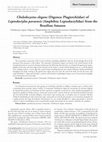
Revista brasileira de parasitologia veterinaria = Brazilian journal of veterinary parasitology : Orgao Oficial do Colegio Brasileiro de Parasitologia Veterinaria
The trematodes are parasites of the several vertebrates including amphibians, however the knowled... more The trematodes are parasites of the several vertebrates including amphibians, however the knowledge about of the taxonomy these parasites is still confuse. The trematode Choledocystus elegans was found in the small intestine of the Leptodactylus paraensis in eastern Amazon and presents the following characteristics: several pointed tegumentary spines, papillae on the outer and inner edges of the oral and ventral suckers, a round, well-developed cirrus sac, a well-developed cirrus, oblique testicles, a ovary right side, uterine loops extending between the testicles, follicular vitellaria distributed throughout the body, starting at the genital pore region and caeca close the end of the body. For the first time, this study identified C. elegans parasitizing L. paraensis and describes morphological aspects never characterized using light and scanning electron microscopy.
Helminthologia, 2015
SummaryA new species of nematode, from the family Spiruridae, is described using parasites from t... more SummaryA new species of nematode, from the family Spiruridae, is described using parasites from the esophageal mucosa of
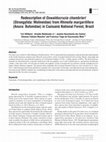
Acta parasitologica / Witold Stefański Institute of Parasitology, Warszawa, Poland, 2016
Oswaldocruzia chambrieri Ben Slimane et Durette-Desset, 1993 is redescribed from specimens collec... more Oswaldocruzia chambrieri Ben Slimane et Durette-Desset, 1993 is redescribed from specimens collected from the small intestine of the South American common toad, Rhinella margaritifera, from Caxiuanã National Forest in Pará, Brazil, using light and scanning microscopy and molecular analysis of Cytochrome Oxidase I (COI) - coding regions of DNA. The discovered nematodes are characterized by a type III caudal bursa with two papillae, rays 4 with a median groove, and spicules divided into a blade, a shoe and a fork. Cervical alae are absent, the cephalic vesicle is divided into two portions, and the synlophe has low ridges without chitinous supports. The present study establishes the Caxiuanã National Forest as a new location for O. chambrieri, which had previously been reported as a parasite of R. margaritifera in Ecuador, uses light microscopy and scanning electron microscopy (SEM) to identify new morphological characters of the species and represents the second molecular sequence dep...
Revista Brasileira de Parasitologia Veterinária, 2016
Absctract Eustrongylides spp. nematodes have birds as final hosts and uses other vertebrates as i... more Absctract Eustrongylides spp. nematodes have birds as final hosts and uses other vertebrates as intermediate/paratenic host (fish, amphibians and reptiles) and have zoonotic potential. In amphibians, the larvae may be located in the subcutaneous tissues, liver and mesentery, between the muscle fibres, especially in the lower limbs. Rhinella marina, which is widely observed in Brazil, has exhibited complex diversity in its helminth fauna, reflecting the unique habitat of the Amazon biome. For the first time, this study describes the morphological aspects of third-stage larvae of Eustrongylides sp. in Rhinella marina from Santa Cruz do Ararí, Marajó Archipelago, Eastern Amazonia, using light and scanning electron microscopy.
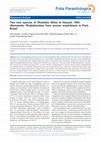
Folia Parasitologica, 2016
Two new lung-dwelling nematode species of the genus Rhabdias Stiles et Hassall, 1905 were discove... more Two new lung-dwelling nematode species of the genus Rhabdias Stiles et Hassall, 1905 were discovered in Caxiuanã National Forest, Pará state, Brazil. Rhabdias galactonoti sp. n. was found in a dendrobatid frog Adelphobates galactonotus (Steindachner). The species is characterised by the regularly folded inner surface of the anterior part of the buccal capsule seen in apical view, flaskshaped oesophageal bulb and narrow, elongated tail. Rhabdias stenocephala sp. n. from two species of leptodactylid frogs, Leptodactylus pentadactylus (Laurenti) (type host) and L. paraensis (Heyer), is characterised by a narrow anterior end that is separated from the remaining body by a constriction. Both species possess six small but distinct lips, a cuticle that is inflated along the whole body, a doliiform buccal capsule separated into a longer anterior and a shallow, ring-shaped posterior part, lateral pores in the body cuticle and zones of spermatogenesis in the syngonia. Rhabdias galactonoti sp. n. is the first species of the genus found in Dendrobatidae; R. stenocephala sp. n. is the second species described from Leptodactylidae in eastern Amazonia.
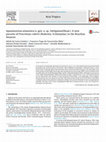
Acta Tropica, 2015
A new species of nematode, Squamasnema amazonica n. gen. n. sp., is described based on specimens ... more A new species of nematode, Squamasnema amazonica n. gen. n. sp., is described based on specimens found parasitizing the small intestine of Proechimys roberti (Rodentia: Echimyidae) collected during a survey of the fauna of Tapirapé-Aquirí National Forest (Brazil, Eastern Brazilian Amazon). The nematodes were fixed and processed for light microscopy and scanning electron microscopy (SEM). These nematodes were classified under the family Heligmonellidae and the subfamily Heligmonellinae. Although several species in the family Heligmonellidae exhibit discontinuous ridges, Squamasnema n. gen. and Trichotravassosia are the only genera with columns of scales along their entire body, as an apomorphy of the synlophe. Squamasnema n. gen. has columns of cuticular cells along its body, except for on the left flank, and exhibits a synlophe with no size gradient or inclination and does not present chitinized structures supporting the synlophe. Therefore, due to these morphological differences of Squamasnema n. gen., the creation of a new genus was necessary.
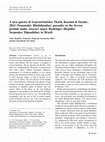
Systematic Parasitology, 2014
Serpentirhabdias atracti n. sp. is described based on specimens discovered in the lung of Atractu... more Serpentirhabdias atracti n. sp. is described based on specimens discovered in the lung of Atractus major Boulenger from Caxiuanã National Forest, Pará, Brazil. The new species is assigned to Serpentirhabdias Tkach, Kuzmin & Snyder, 2014 based on morphological characters (comparatively thin body cuticle without prominent inflations, arrangement of circumoral papillae in two lateral groups, pre-equatorial position of vulva, eggs in uteri at early cleavage stages), as well as because of its parasitism in snakes. The new species is most similar to S. vellardi (Pereira, 1928) due to the absence of lips and buccal capsule, similar body dimensions, and the specificity to dipsadid snakes in Brazil. The two species differ in the shape of the tail (bulbous dilatation in the posterior part followed by a threadlike tail tip present in S. atracti n. sp.), the width of the oesophagus, and the size of the excretory glands. Serpentirhabdias atracti n. sp. is the sixth species of this genus found in the Neotropical Region.
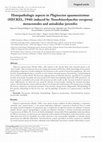
Revista Brasileira de Parasitologia Veterinária, 2014
Plagioscion squamosissimus (Heckel 1840), a fish endemic to the Amazon Basin and commonly known a... more Plagioscion squamosissimus (Heckel 1840), a fish endemic to the Amazon Basin and commonly known as the “silver croaker”, plays an important role in the ecology and economy of Pará State, Brazil. Knowledge of host-parasite relationships is important to understanding the role of parasites in the control of natural host populations. This work describes histopathological aspects caused by several common intestinal parasites found during a helminthological survey of fish in northern Brazil. We observed a high prevalence of helminth infection, especially by J3 nematode juveniles of the family Anisakidae and metacestodes of the family Protocephalidae (both with 100% prevalence). An external capsule surrounded each juvenile with numerous juveniles inside sac-like structures formed of connective tissue. Inflammation was observed to be caused by infection of metacestodes, reaching the intestinal muscularis mucosa. Neoechinorhynchus veropesoi (38% prevalence) was found in the small intestine o...
Systematic Parasitology, 2013
PLoS Neglected Tropical Diseases, 2012
Memórias do Instituto Oswaldo Cruz, 2011
The nematodes of the genus Rhabdias Stiles et Hassall, 1905 are parasites of the lungs of amphibi... more The nematodes of the genus Rhabdias Stiles et Hassall, 1905 are parasites of the lungs of amphibians and reptiles in both tropical and temperate regions. The females are parasites and reproduce predominantly by hermaphroditism and rarely by parthenogenesis (Anderson 2000). More than 70 species of this genus have been described in Lissanphibia and Squamata. Of these, 18 have been found in bufonid anurans (
Journal of Parasitology, 2010
Parasitology International, 2013
Brasicystis bennetti Thatcher, 1979 was first described from specimens obtained from the subcutan... more Brasicystis bennetti Thatcher, 1979 was first described from specimens obtained from the subcutaneous tissues of the mouth and operculum of Plagioscyion squamosissimus from the Amazon River in Brazil, however since 2008, Brasicystis has been considered a genus inquirendum. This study reviews some of the diagnostic characters from the original description of B. bennetti from the Amazon Delta, and redescribes the genus and species with a discussion of their taxonomic status. Ultrastructural and molecular approaches complement the data presented on this monotypic genus. The diagnosis of the tribe Didymozoini Monticelli, 1888 is amended to incorporate the genus Brasicystis, which is redescribed and revalidated here, with the proposal of an amended key.











Uploads
Papers by Francisco Tiago De Vasconcelos Melo